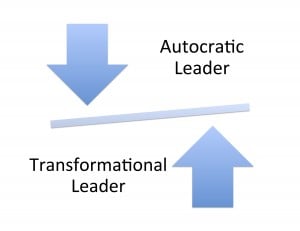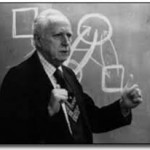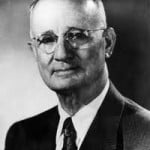“You have inherited a lifetime of tribulation. Everybody has inherited it. Take it over, make the most of it and when you have decided you know the right way, do the best you can with it.” – Murray Bowen

Leadership As We Have Been Taught is Wrong!
This post has been inspired by the TED Talk by Dan Pallotta on “How We Think of Charity Is Way Wrong.”
I must admit that I’ve been struggling with this topic for many, many years as I work with leaders functioning under a limit to their effectiveness…how they have been taught! When I was having lunch with a local clergyperson nearing retirement, he proudly stated, “I voted for Obama because I’m a Yellow Dog Democrat. That’s what I’ve been taught and that’s what I do.” I thought that it was a shame that this man has lived his life under the pressure of what had been taught to him. I have realized that many of us are unaware of the DNA imposed on us by our family of origin and how it impacts our decisions. This leads us down a troubled road, indeed. I’ve given definition of leadership alternatives. The work of Murray Bowen has been especially helpful in my work. His perspective is to learn about ourselves by learning about our family of origin. Things are neither right nor wrong. They just are.
In 2013, the Meyer Foundation surveyed nearly 100 executive directors of nonprofit organizations to learn how it could best support them. Executive directors reported a range of challenges affecting their effectiveness; some of the most commonly cited were fundraising, personnel management, and working with boards of directors.
“These people are sacrificing so much to take on the executive roles of these groups,” Julie Rogers, President of the Meyer Foundation in Washington, D.C., said. “We are watching people not just burn out but make themselves sick in service of their communities. It’s our job to take care of them.” *
We have been taught leadership in ways that inhibit our ability to lead. We think that the leader is the boss and must have all the right answers. We think, therefore, that asking others for input into decisions, delegation, collaboration, and observing group process are examples of weak leadership, when, in fact, these are examples of effective leadership.

The Autocratic leadership model is what many people view as strong leadership. It’s an example of Charismatic Leadership, an example of leadership that’s all about the leader. It’s all about power of position. It’s ultimately a bottle-neck for decision-making if every decision must come to the leader for approval. It also represents a lack of trust by the leader in the members of the team.
Reframing leadership means learning a different style of leadership. Both Transformational Leadership and Bowen Family Systems are effective systems for leaders to embrace. There’s a synergy in these two systems. Transformational Leadership is about building high-performing cultures by building leaders on teams. Bowen Systems is about managing self as a leader.
Here is a summary of the major points of these powerful and scalable systems.
Transformational Leadership
The transformational leader:
- Clearly Articulates Vision And Goals – Having a vision and being able to effectively communicate that vision is key.
- Defines Things Others Can Do – Getting things off their plate, so to speak, is a primary team-building skill.
- Builds Leaders Within Teams – Elevating others and mentoring others in the culture of transformation is the culture of high performance.
- Effectively Delegates – A very underutilized and misunderstood skill that must be mastered.
- Encourages Boldness – Creating a culture of affirmation and a safe culture to learn from mistakes is healthy.
- Gives Information And Support – Withholding information, whether intentional or not, is a barrier to success.
- Affirms And Celebrates Competence – Give as much or more attention to affirmation as to correction. Celebrate often!
- Respects The Individual – Effective leadership is based on effective relationships.
- Avoids Micromanaging – This is the ultimate team killer! It’s not good.
- Models What They Preach – The leader sets the bar and creates the pace for the culture.
Books on Transformational Leadership **
Transforming Power: Stories from Transformational Leaders for Encouragement and Inspiration, Hugh Ballou
Transforming Leadership, James Alexander Burns
Transformational Leadership, Bernard M. Bass

Bowen Systems
There are 8 concepts of Bowen Theory. Here’s a summary of the concepts. Check the link to the Bowen Center at Georgetown University (http://www.thebowencenter.org) for more information.
8 Concepts of Bowen Family Systems
- Triangles – When there are three people in a relationship. Triangles are neither good nor bad – they are. Triangles sometimes have one person on the outside when the other two are strongly connected, causing tension.
- Differentiation of Self – Strong grounding in personal guiding principles where a person does not depend on the approval of others for decisions. Each person in a group emotional system thinks for themselves rather than opting in to the will of the group in what’s called “group think.”
- Nuclear Family Emotional System – The basic family unit is where we learn patterns and behaviors. By observing our family, we learn about ourselves and gain abilities to observe other emotional systems.
- Family Projection Process – We all inherit problems and strengths from our parents who have projected their fears and hopes onto us. Observing these patterns frees us to be independent and function in basic self.
- Multigenerational Transmission Process – We all possess learned behaviors that have been taught to us knowingly and unknowingly through multiple generations. Response to these emotional triggers results in less differentiation of self. Observing these patterns allows us to make good decisions, staying true to our basic self.
- Emotional Cutoff – This is where we avoid or minimize contact with people with whom we have unresolved tension. Often, we establish new relationships as a substitute with the same issues appearing over time. Meanwhile, the tension continues with the original person, creating unresolved anxiety.
- Sibling Position – Bowen continues the research of Walter Toman on the patterns of sibling position. Be aware of our position as well as the position of others in our emotional systems.
- Societal Regression/Societal Emotional Process – There are parallel patterns in society and family systems. Observing these patterns of regression and progression can inform us about our personal relationship patterns in families and in organizations.
Books by Roberta Gilbert on Bowen Systems:**
The Eight Concepts of Bowen Theory
Extraordinary Relationships: A New Way of Thinking About Human Interactions
Enjoy learning and leading!
* Post by Lori Bartczak on Stanford Social Innovation Review
** Affiliate fees benefit SynerVision Leadership Foundation.
Hugh Ballou
The Transformational Leadership Strategist TM
Read about me on Forbes












